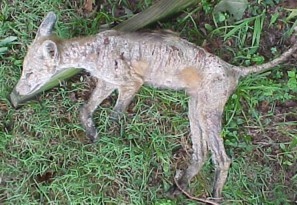 .
.Sarcoptic mange is a common fox disease caused by a parasitic mite called Sarcoptes scabiei, which burrows into the skin, with infestations of several thousand mites per square inch possible.
Scabies mites secrete a yellowish waste that hardens into a thick crust on the skin, causing hair loss and (as infestations progress) lacerations and cracking of the skin. Chronic itching can cause the fox to bite and gnaw at itself, and the animal can become dazed from pain and lack of sleep. Weight loss from stress can be quite rapid, and organ failure is common. Death usually follows within six months of infestation.
One of the chief causes of mange in wild fox populations is too high a fox density. Mange mites can survive a long period of time in a den, which means that effective mange control requires fox dens to be unoccupied at least one year out of every two.
In areas where fox trapping and hunting is outlawed or discouraged, however, fox population densities will often rise to the point that some dens never lie fallow. In such situations mange mites colonize the den and parasitize generation after generation of foxes who die horrible and grisy deaths.
Death by mange is a long and nasty torture, and far more cruel than the swift death offered by a hunter's bullet or the swift chop of a working lurcher or hound.
Anyone who truely cares about animal welfare should favor a return to managed population control of animal species that have overshot their carrying capacity. Death is not an option -- all animals die. The only real question is how an animal will die and under what circumstances. Managing wildlife through regulated hunting is a far more humane alternative that death through disease, starvation and vehicle impact.
.
No comments:
Post a Comment